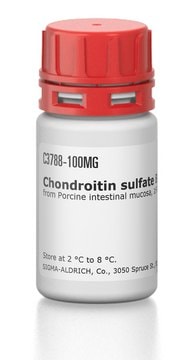C3920
Chondroitin disaccharide Δdi-0S sodium salt
≥95% (HPLC)
Synonym(s):
α-ΔUA-[1→3]-GalNAc
About This Item
Recommended Products
Assay
≥95% (HPLC)
form
powder
color
white
solubility
H2O: soluble 10 mg/mL, clear, colorless
storage temp.
−20°C
SMILES string
[Na].CC(=O)NC(C=O)C(OC1OC(=CC(O)C1O)C(O)=O)C(O)C(O)CO
InChI
1S/C14H21NO11.Na.H/c1-5(18)15-6(3-16)12(10(21)8(20)4-17)26-14-11(22)7(19)2-9(25-14)13(23)24;;/h2-3,6-8,10-12,14,17,19-22H,4H2,1H3,(H,15,18)(H,23,24);;
InChI key
SDRQEYWJTBWGNE-UHFFFAOYSA-N
General description
Application
Other Notes
Storage Class Code
11 - Combustible Solids
WGK
WGK 3
Flash Point(F)
Not applicable
Flash Point(C)
Not applicable
Certificates of Analysis (COA)
Search for Certificates of Analysis (COA) by entering the products Lot/Batch Number. Lot and Batch Numbers can be found on a product’s label following the words ‘Lot’ or ‘Batch’.
Already Own This Product?
Find documentation for the products that you have recently purchased in the Document Library.
Customers Also Viewed
Articles
Glycosaminoglycans are large linear polysaccharides constructed of repeating disaccharide units.
Glycosaminoglycans are large linear polysaccharides constructed of repeating disaccharide units.
Glycosaminoglycans are large linear polysaccharides constructed of repeating disaccharide units.
Glycosaminoglycans are large linear polysaccharides constructed of repeating disaccharide units.
Our team of scientists has experience in all areas of research including Life Science, Material Science, Chemical Synthesis, Chromatography, Analytical and many others.
Contact Technical Service







